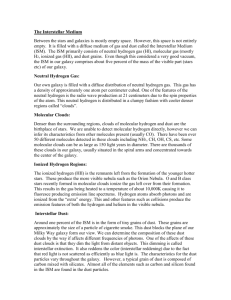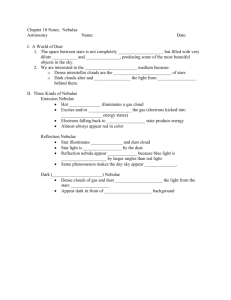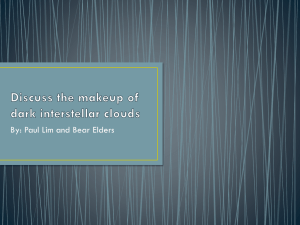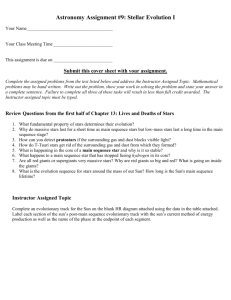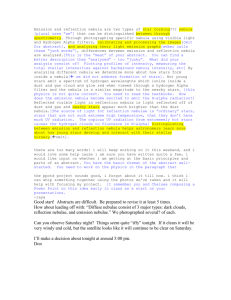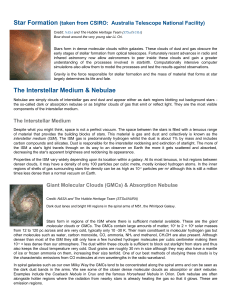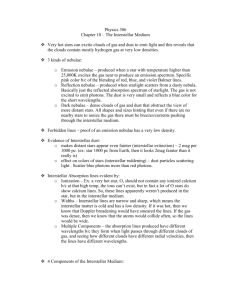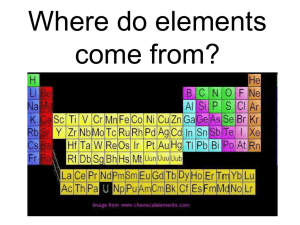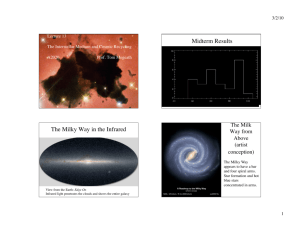Starbirth and Interstellar Matter
advertisement
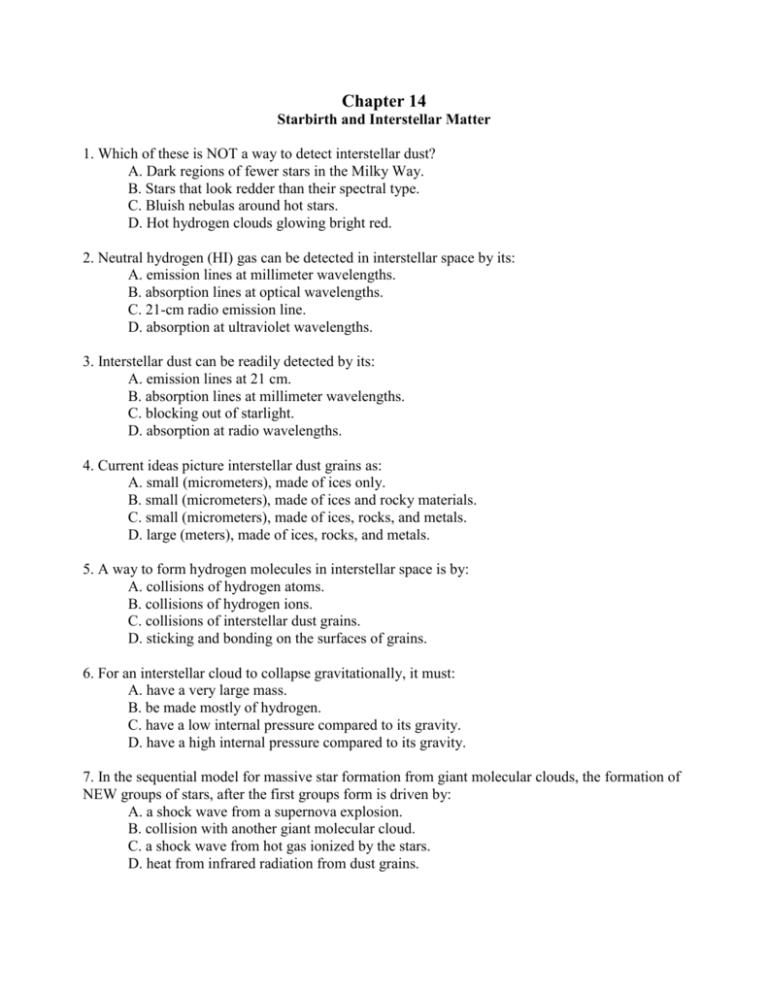
Chapter 14 Starbirth and Interstellar Matter 1. Which of these is NOT a way to detect interstellar dust? A. Dark regions of fewer stars in the Milky Way. B. Stars that look redder than their spectral type. C. Bluish nebulas around hot stars. D. Hot hydrogen clouds glowing bright red. 2. Neutral hydrogen (HI) gas can be detected in interstellar space by its: A. emission lines at millimeter wavelengths. B. absorption lines at optical wavelengths. C. 21-cm radio emission line. D. absorption at ultraviolet wavelengths. 3. Interstellar dust can be readily detected by its: A. emission lines at 21 cm. B. absorption lines at millimeter wavelengths. C. blocking out of starlight. D. absorption at radio wavelengths. 4. Current ideas picture interstellar dust grains as: A. small (micrometers), made of ices only. B. small (micrometers), made of ices and rocky materials. C. small (micrometers), made of ices, rocks, and metals. D. large (meters), made of ices, rocks, and metals. 5. A way to form hydrogen molecules in interstellar space is by: A. collisions of hydrogen atoms. B. collisions of hydrogen ions. C. collisions of interstellar dust grains. D. sticking and bonding on the surfaces of grains. 6. For an interstellar cloud to collapse gravitationally, it must: A. have a very large mass. B. be made mostly of hydrogen. C. have a low internal pressure compared to its gravity. D. have a high internal pressure compared to its gravity. 7. In the sequential model for massive star formation from giant molecular clouds, the formation of NEW groups of stars, after the first groups form is driven by: A. a shock wave from a supernova explosion. B. collision with another giant molecular cloud. C. a shock wave from hot gas ionized by the stars. D. heat from infrared radiation from dust grains. 8. Low-mass stars like the sun may possibly form: A. after a supernova explosion. B. in groups within dark clouds. C. as companions to massive stars. D. one at a time out of giant molecular clouds. 9. Which of these statements is NOT true of the formation of massive stars? A. They form from material in the giant molecular clouds. B. They form quickly, in less than a million years. C. They form in small groups of about 10 stars at a time. D. They form after the smaller stars like the sun. 10. Which of these does not lead us to expect starbirth is occurring NOW in our galaxy? A. Infrared observations of possible protostars. B. Bipolar outflows associated with infrared sources. C. A cluster of infrared sources near the Orion Nebula. D. The ages of the stars within the globular clusters. 11. The observations of bipolar outflows of gas from regions of star formation in molecular clouds indicate: A. newly born stars move in two directions. B. a ring or torus of material around the young stars. C. hot dust causes the gas to move rapidly. D. every star forms with a planetary system. 12. Large envelopes called H II regions typically surrounding hot stars contain: A. methane gas. B. neutral hydrogen. C. interstellar dust D. ionized hydrogen. 13. The reddening observed in nebulae is caused by: A. the emission of light from neutral hydrogen gas. B. the re-emission and scattering of light by dust molecules. C. interactions of hydrogen with coronal gas. D. fusion reactions in the core of dust molecules. 14. Planets can form in the _______ region around a newly born star. A. toroidal, rotating disk B. bipolar outflow C.coronal D. sunspot 15. Interstellar gas consists of: A. atoms. B. molecules. C. ions. D. all of the above 16. A bright nebula that arises from the scattering of starlight by dust particles is called a: A. reflection nebula. B. brightness nebula. C. luminous nebula. D. emission nebula. 17. Generally, interstellar dust makes itself known by: A. outgassing. B. pulsing. C. extinction and reddening. D. glowing bright red around hot stars. 18. The Orion Nebula is a: A. supernova remnant. B. constellation. C. giant molecular cloud. D. planetary nebula. 19. Coronal interstellar gas is about the same temperature as our sun's coronal gas and is detected by: A. X-rays. B. gamma-rays. C. radio waves. D. optical observations. 20. We refer to neutral hydrogen in space as: A. H I regions. B. H II regions. C. coronal gas. D. a molecular cloud. 21. We refer to ionized hydrogen in space as: A. H I regions. B. H II regions. C. coronal gas. D. a molecular cloud. 22. The 21 cm radiation is due to the flip of the spin of the: A. neutron. B. proton. C. electron. D. quark. 23. In the very young open cluster of bright blue stars, which have already evolved to the main sequence? A. The more massive stars. B. The less massive stars. C. The less luminous stars. D. The coolest stars. 24. On the H-R diagram, where do the first stars to form fall on the main sequence? A. Upper right. B. Center. C. Upper left. D. Lower right. 25. The Lagoon Nebula in Sagittarius glows bright red due to: A. old red supergiants imbedded in the nebula. B. the extinction of starlight by dust in the way. C. ionized hydrogen (If II) glowing around hot young stars. D. the blue light being diffused by the dust around the stars. 26. In a condensing star, the leftover gas might make ______ planets while the dust might condense into __________ planets. A. terrestrial, jovian B. jovian, terrestrial C. little, big D. very dense, low density 27. Molecules in space are most likely found in: A. bright H II regions. B. dark nebulae like the Horsehead. C. planetary nebulae like the Ring. D. supernova remnants like the Crab. 28. Which of these molecules has not yet been found in interstellar space? A. Water. B. Carbon monoxide. C: DNA. D. Hydrogen cyanide. ESSAYS 1. Distinguish between H I and H II regions in terms of temperature and atomic structure. 2. Why are the bright red regions in the centers of H II regions not good places to find dense molecular clouds? Then why are these clouds still relatively close to them? 3. Explain the blue color of reflection nebulae like those around the Pleiades in terms of the color of our sky. 4. Why are giant molecular clouds associated with dark instead of bright nebulae? 5. Why is it much easier to find molecules in space with radio rather than optical telescopes?
